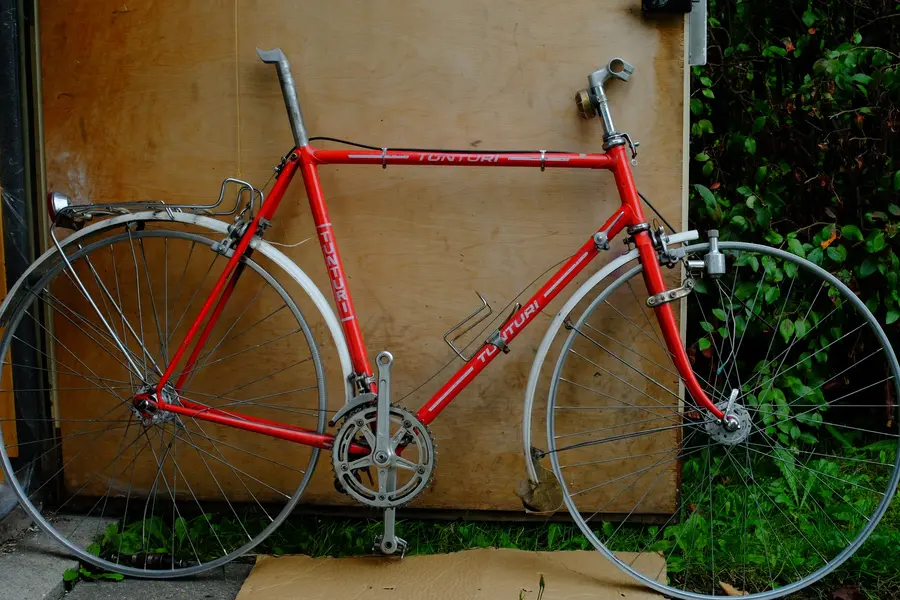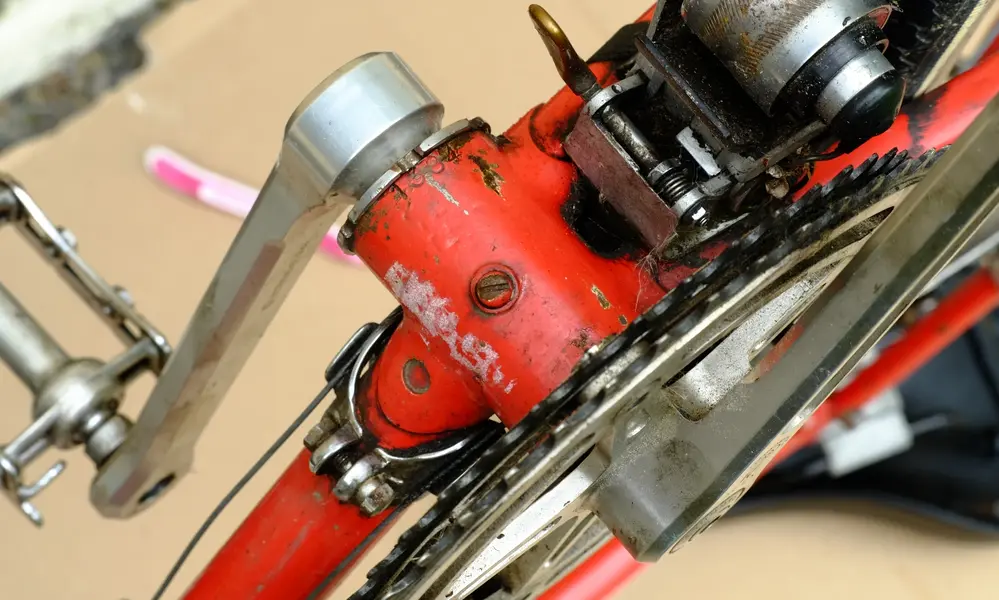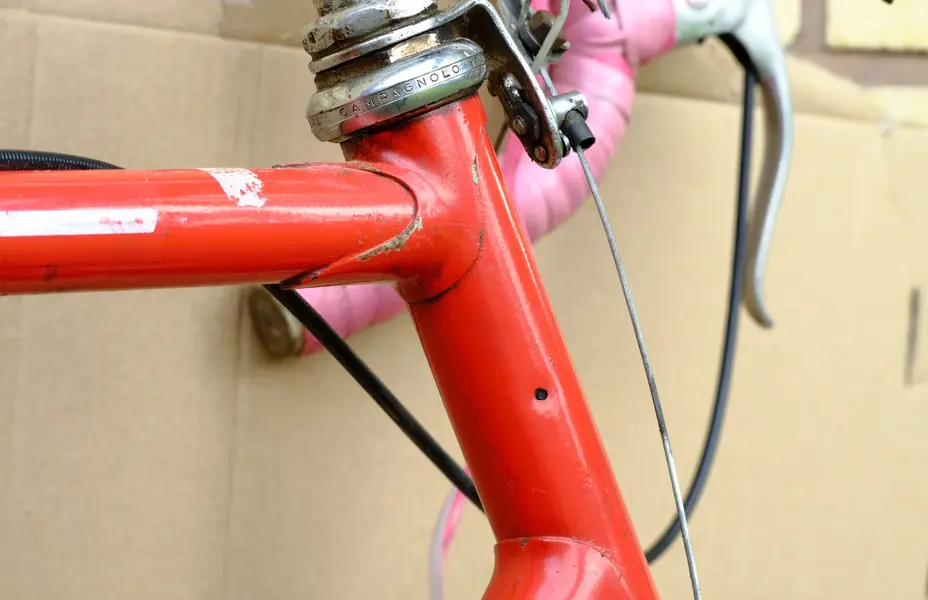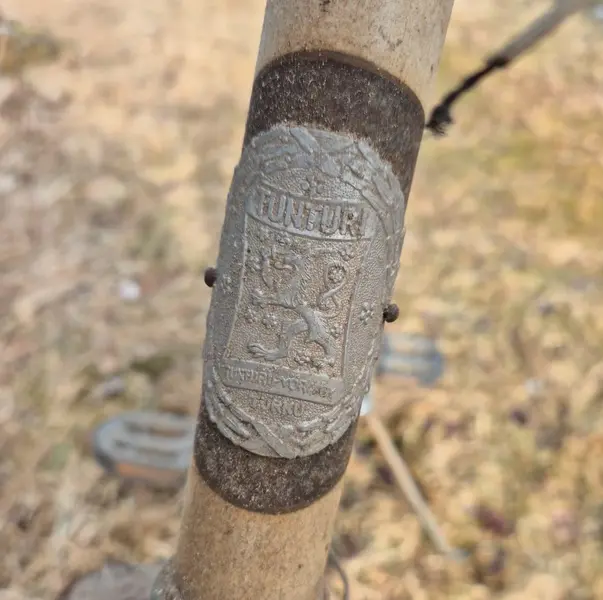You are using an out of date browser. It may not display this or other websites correctly.
You should upgrade or use an alternative browser.
You should upgrade or use an alternative browser.
Parts , bikes and project bikes
- Thread starter SteelNipple
- Start date
juvela
Retro Guru
-----
"Georg Fischer, BB surfaces have been faced down to 68mm."
is this one of the sandcast ones with the prominent lip on the drive side?
modification means that one could not fit a SPECTA or Verot bottom bracket assembly without resort to spacer washers
these two firms do not offer spindles for 70mm shells , probably for economy, and accommodate Italian dimension by making the walls of the Italian cups one mm thicker than those of their BSC, CH & metric cups
can come up as a limitation on some Belgian machines constructed with 70mm BSC shells; Flandria for example
---
"frère meaning brother?"
yes, old/original name of firm was this
referring to Jacques Andre Huret & Roger Henri Huret
---
"drum size"
you experience 180 degree of lever travel due to the small drum diameter of these levers; they take more lever travel to move the cable a given amount than other brands
~'74 they joined with the rest of the known universe with regard to drum diameter
---
"Have the laurel and shield/knight crest mod. 64 bars with three knurled rings and 1A "Cinelli Milano" stem."
AFAIK 1A stem not extant at this epoch
'LXIII was approximate launch date for Tecno Tubo Torino but would be a bit grey/iffy IMHO
hence would expect Ambrosio Champion
---
frame certainly appears Cino inspired
-----
"Georg Fischer, BB surfaces have been faced down to 68mm."
is this one of the sandcast ones with the prominent lip on the drive side?
modification means that one could not fit a SPECTA or Verot bottom bracket assembly without resort to spacer washers
these two firms do not offer spindles for 70mm shells , probably for economy, and accommodate Italian dimension by making the walls of the Italian cups one mm thicker than those of their BSC, CH & metric cups
can come up as a limitation on some Belgian machines constructed with 70mm BSC shells; Flandria for example
---
"frère meaning brother?"
yes, old/original name of firm was this
referring to Jacques Andre Huret & Roger Henri Huret
---
"drum size"
you experience 180 degree of lever travel due to the small drum diameter of these levers; they take more lever travel to move the cable a given amount than other brands
~'74 they joined with the rest of the known universe with regard to drum diameter
---
"Have the laurel and shield/knight crest mod. 64 bars with three knurled rings and 1A "Cinelli Milano" stem."
AFAIK 1A stem not extant at this epoch
'LXIII was approximate launch date for Tecno Tubo Torino but would be a bit grey/iffy IMHO
hence would expect Ambrosio Champion
---
frame certainly appears Cino inspired
-----
SteelNipple
Retro Guru
Not the type with the lip. Could have been 70mm, but now thinking about it, as the parts are mostly late 70s, my guess is that the bike was overhauled then and the maybe original 74mm BB and Magistroni crank was removed in favor of the square taper.-----
"Georg Fischer, BB surfaces have been faced down to 68mm."
is this one of the sandcast ones with the prominent lip on the drive side?
modification means that one could not fit a SPECTA or Verot bottom bracket assembly without resort to spacer washers
these two firms do not offer spindles for 70mm shells , probably for economy, and accommodate Italian dimension by making the walls of the Italian cups one mm thicker than those of their BSC, CH & metric cups
can come up as a limitation on some Belgian machines constructed with 70mm BSC shells; Flandria for example
---
Traction Avant... Always frères in the bicycle industry."frère meaning brother?"
yes, old/original name of firm was this
referring to Jacques Andre Huret & Roger Henri Huret
---
I didn't understand it because I thought that Huret had the larger drum..."drum size"
you experience 180 degree of lever travel due to the small drum diameter of these levers; they take more lever travel to move the cable a given amount than other brands
~'74 they joined with the rest of the known universe with regard to drum diameter
---
"1963, Mod. 1A (A = aluminum) forged aluminum alloy stem and aluminum alloy handlebar production begins; stems and bars have a non-anodized, polished finish till 1965.""Have the laurel and shield/knight crest mod. 64 bars with three knurled rings and 1A "Cinelli Milano" stem."
AFAIK 1A stem not extant at this epoch
'LXIII was approximate launch date for Tecno Tubo Torino but would be a bit grey/iffy IMHO
hence would expect Ambrosio Champion
---
"The first version of the aluminum bar has a long, bulge-formed center section, no knurled rings and a non-anodized, polished finish. The second version has an engraved sleeve like the steel bars, with two rings of knurling at the clamping area and a polished finish till 1965 with the start of the clear anodized finish, then three rings of knurling and finally a single ring of knurling."
Source: http://www.velo-retro.com/cinellitline.html
"At the Rome Olympics Cino Cinelli introduces the product which will become most strongly associated with the brand’s name: the aluminum 1A stem and its accompanying series of handlebars."
Source: https://www.cinelli-milano.com/pages/history
Yes.frame certainly appears Cino inspired
-----
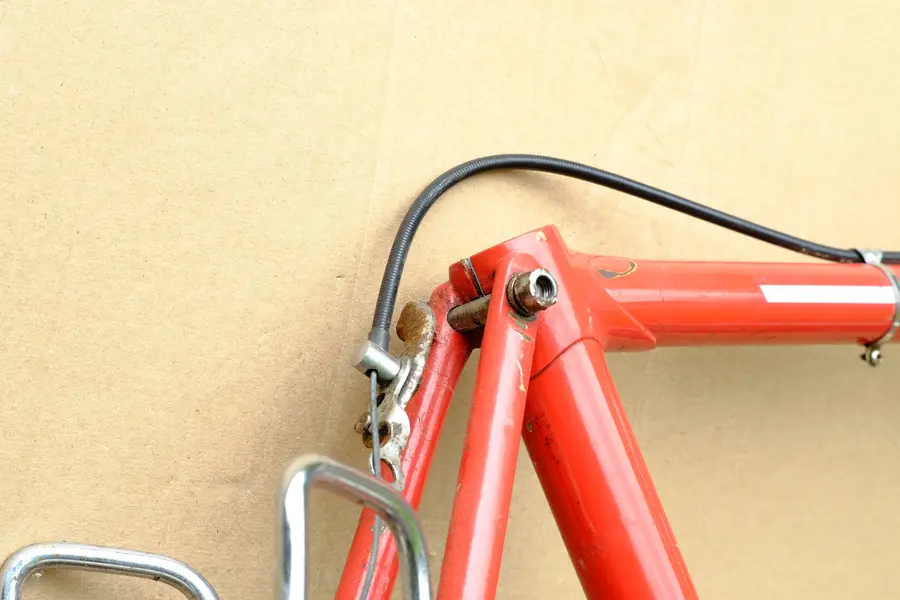
Last edited:
SteelNipple
Retro Guru
juvela
Retro Guru
-----
"Not the type with the lip. Could have been 70mm, but now thinking about it, as the parts are mostly late 70s, my guess is that the bike was overhauled then and the maybe original 74mm BB and Magistroni crank was removed in favor of the square taper."
WOW, that would be a "whole lotta facing": 3mm from each side
if you have ever used a hand facer you know your arms would probably fall off before you got there...AND you would have had to send your facing cutter out for sharpening as well...
BTW - Windsor/Carabela of Mexico City produced a large number of cycles which sported 68mm Italian thread shells, have had them come through me arbeidstationen
---
1A -
thank you for the information on the launch date
had never known a specific one

example shown in your photo is not the launch version "G1"
launch version had a hex nut for the binder

http://velobase.com/Pages/ViewCompo...410-4170-9380-C60BD8D75DB1&Enum=102&AbsPos=95
---
video -
me layman's guess would be that host a genuine Finn; while his last name has only five letters it manages to have three K's
an appropriate name for production company might be "Bad Hairgoods Are Us"
---
Cino inspired frames -
there were several Italian producers who did blatant Cinelli replicas back in the 1960's
one marque recalled is that of Pinzani
here is an example -

this chappie a replica of a Model B
https://www.bikeforums.net/classic-...4834-late-60s-early70s-pinzani-road-bike.html
-----
"Not the type with the lip. Could have been 70mm, but now thinking about it, as the parts are mostly late 70s, my guess is that the bike was overhauled then and the maybe original 74mm BB and Magistroni crank was removed in favor of the square taper."
WOW, that would be a "whole lotta facing": 3mm from each side
if you have ever used a hand facer you know your arms would probably fall off before you got there...AND you would have had to send your facing cutter out for sharpening as well...
BTW - Windsor/Carabela of Mexico City produced a large number of cycles which sported 68mm Italian thread shells, have had them come through me arbeidstationen
---
1A -
thank you for the information on the launch date
had never known a specific one
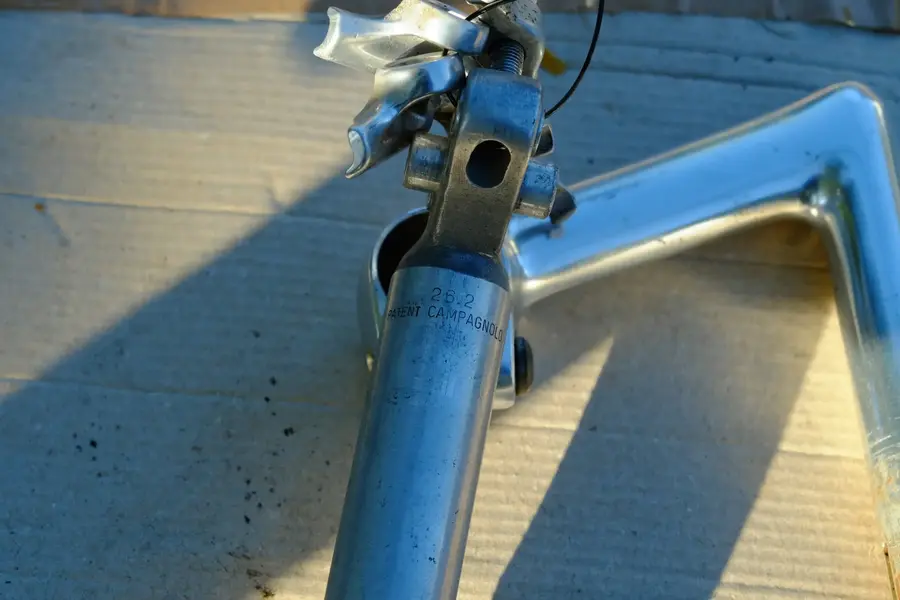
example shown in your photo is not the launch version "G1"
launch version had a hex nut for the binder
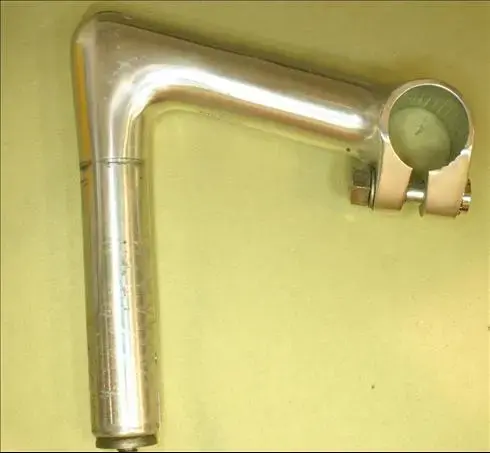
http://velobase.com/Pages/ViewCompo...410-4170-9380-C60BD8D75DB1&Enum=102&AbsPos=95
---
video -
me layman's guess would be that host a genuine Finn; while his last name has only five letters it manages to have three K's
an appropriate name for production company might be "Bad Hairgoods Are Us"
---
Cino inspired frames -
there were several Italian producers who did blatant Cinelli replicas back in the 1960's
one marque recalled is that of Pinzani
here is an example -
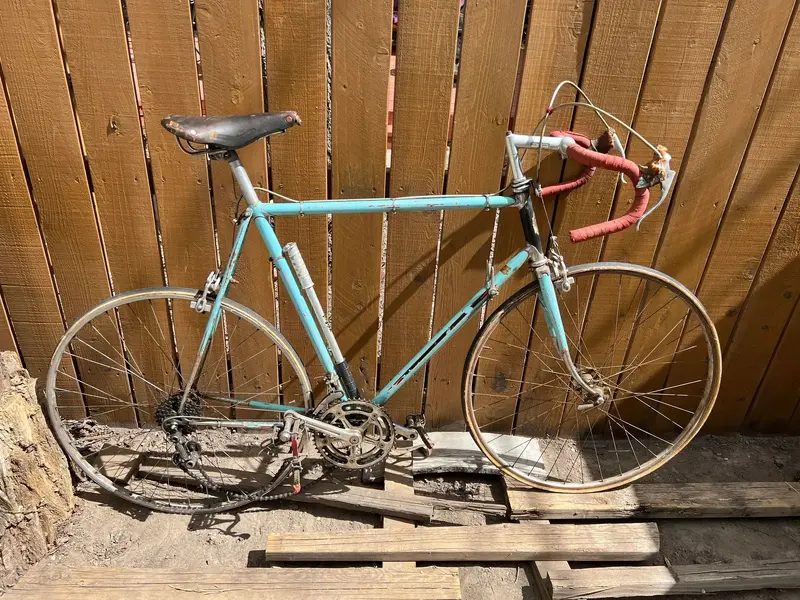
this chappie a replica of a Model B
https://www.bikeforums.net/classic-...4834-late-60s-early70s-pinzani-road-bike.html
-----
SteelNipple
Retro Guru
When the patent text under the "neck" vanished?-----
"Not the type with the lip. Could have been 70mm, but now thinking about it, as the parts are mostly late 70s, my guess is that the bike was overhauled then and the maybe original 74mm BB and Magistroni crank was removed in favor of the square taper."
WOW, that would be a "whole lotta facing": 3mm from each side
if you have ever used a hand facer you know your arms would probably fall off before you got there...AND you would have had to send your facing cutter out for sharpening as well...
BTW - Windsor/Carabela of Mexico City produced a large number of cycles which sported 68mm Italian thread shells, have had them come through me arbeidstationen
---
1A -
thank you for the information on the launch date
had never known a specific one
View attachment 1010149
example shown in your photo is not the launch version "G1"
launch version had a hex nut for the binder
View attachment 1010154
http://velobase.com/Pages/ViewCompo...410-4170-9380-C60BD8D75DB1&Enum=102&AbsPos=95
---
Yes, some older "Mexican Cinellis" with sloping crown are really close, but the lugs are not quite right(on head lugs the front cuts have smaller radius).video -
me layman's guess would be that host a genuine Finn; while his last name has only five letters it manages to have three K's
an appropriate name for production company might be "Bad Hairgoods Are Us"
---
Cino inspired frames -
there were several Italian producers who did blatant Cinelli replicas back in the 1960's
one marque recalled is that of Pinzani
here is an example -
View attachment 1010171
this chappie a replica of a Model B
https://www.bikeforums.net/classic-...4834-late-60s-early70s-pinzani-road-bike.html
-----
I'm hoping that it's a real Cinelli SC. The replicas or copies are usually missing the 26.2mm seatpost, the oil port and drain hole and this one has the four digit serial number in the right place. Long wheelbase. The "divers helmet" RD cable stop came around '63. So my estimate is '63-65.
Last edited:
juvela
Retro Guru
-----
"Yes, some older "Mexican Cinellis" with sloping crown are really close, but the lugs are not quite right(on head lugs the front cuts have smaller radius)."
me comment regarding 68mm oytoy shells not a reference to the Cinelli-esque cycles from ACER-MEX but to some of their lower models of the early seventies such as Carrera Sport
AFAIK the Profesional model always came through with a 70mm shell

ca. 1971 catalogue page from a U.S. distributor
-----
"Yes, some older "Mexican Cinellis" with sloping crown are really close, but the lugs are not quite right(on head lugs the front cuts have smaller radius)."
me comment regarding 68mm oytoy shells not a reference to the Cinelli-esque cycles from ACER-MEX but to some of their lower models of the early seventies such as Carrera Sport
AFAIK the Profesional model always came through with a 70mm shell
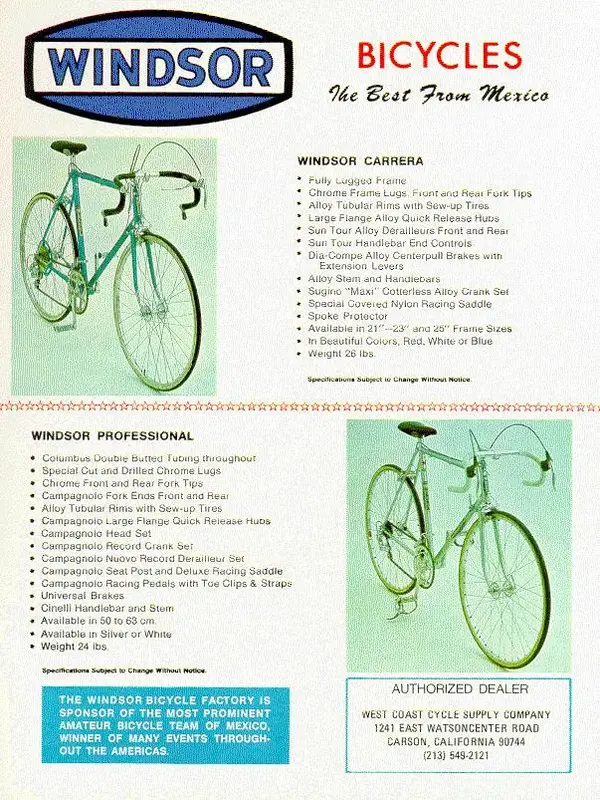
ca. 1971 catalogue page from a U.S. distributor
-----
Similar threads
- Replies
- 0
- Views
- 528
- Replies
- 34
- Views
- 1K
- Replies
- 2
- Views
- 934
Latest posts
-
For Sale Inner Tubes – Michelin & Vittoria – NOS / Excellent Condition
- Latest: 27motorhead
-
-
-
-
